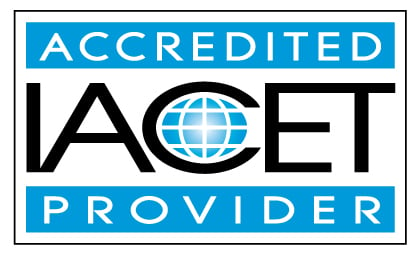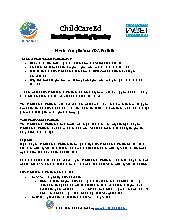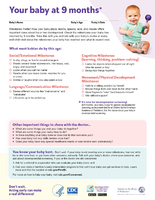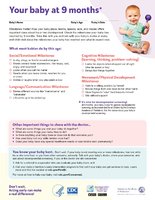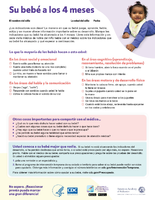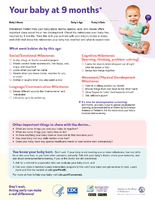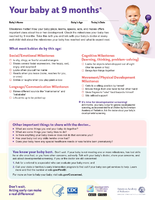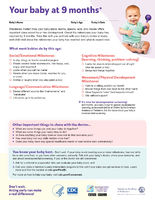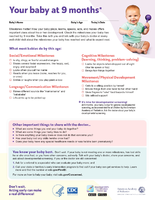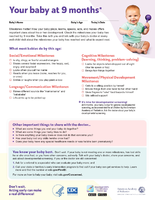CDA Infant/Toddler Credential with Portfolio Review
The CDA Infant/Toddler Credential with Portfolio Review is a 120-hour, self-paced online training for early childhood educators working with infants and toddlers. This program covers all 8 CDA Subject Areas and supports you step-by-step as you prepare for the CDA credentialing process.
Course features include:
- 120 hours of formal ECE training that fulfills the CDA Council’s coursework requirement
- Training across all 8 CDA Subject Areas
- Professional Portfolio resources developed by certified CDA PD Specialists
- A guided Portfolio Review process with feedback from certified CDA PD Specialists
- A step-by-step portfolio instruction video
- Fully online and self-paced so you can learn anytime, anywhere
CDA Course
Portfolio Review: how it works
After you complete the training portion, you must upload your Professional Portfolio documents as PDF files only. Required documents include:
- Reflective Competency Statements for CS I–CS VI
- Professional Philosophy Statement
Our PD Specialists will review your submissions and will either:
- Approve them, or
- Provide feedback and request revisions and resubmission
Your ChildCareEd CDA training certificate is issued only after all coursework is finished and all portfolio documents are accepted.
Important CDA Council requirements (in addition to this course)
This course fulfills the training portion of the CDA, but to earn the CDA Credential you must also complete the Council’s full process, including:
- At least 480 hours of work experience with children ages birth-36 months in a center based setting.
- Submission of your Professional Portfolio digitally when you apply
- Successful completion of the CDA Exam and typically a Verification Visit.
Disclaimer
ChildCareEd provides CDA training and portfolio support, but does not issue the CDA Credential. Completing this course (even with Portfolio Review) does not mean you have earned a CDA Credential. The CDA Credential is awarded only by the Council for Professional Recognition after you meet all Council requirements.
➡️ Learn more about credentialing steps and apply through the CDA Council’s official website.
By the end of this training, the learner will be able to:
- Identify the causes and locations of child injuries at childcare settings.
- Demonstrate an understanding of how genetics and environment influence child growth and development.
- Identify resources addressing health, safety and nutrition topics (CPR, 911, CDC, WIC, Poison Control)
- Identify strategies for providing appropriate care for infants and toddlers with chronic health issues
- Identify recommended medical and immunization schedules for children birth through age three
- Identify strategies for effective communication with families.
- Give examples of ways to apply and model ethical behavior and professional integrity with all children and youth.
- Give examples of ways to apply and model ethical behavior and professional integrity with community members and organizations.
- Give examples of ways to apply and model ethical behavior and professional integrity with families.
- Identify and contemplate bias and explore anti-bias approaches that support working with children and families.
- Give examples of appropriate sensory activities for infants and toddlers.
- Demonstrate understanding of an IEP and removing barriers
- Demonstrate an understanding of translating assessment and observational information into short and long term goal development
- Identify strategies to prevent Adverse Childhood Experiences
- Demonstrate understanding of brain development in young children.
- Demonstrate an understanding of how ongoing preventive health and wellness care affects child development
- Identify strategies to promote cultural diversity and acceptance in the child care environment.
- List examples ways to incorporate inclusion and equity in the classroom
- Identify resources to help children discover, learn, and experience in a natural play environment.
- Identify materials and equipment for center childcare programs that meet the needs of specific age groups in both shared or permanent space and align with the programs curriculum
- Explain the value of self-evaluation and reflection.
- Identify significant events surrounding the evolution of early childhood education in America.
- Identify current events impacting Early Childhood Education.
- Identify appropriate activities for children birth through age three
- Give examples of strategies to help children resolve conflict amongst themselves.
- Identify the signs of traumatic brain injury in infants and young children.
- Demonstrate understanding of observational techniques to track skill development and individual need.
- Demonstrate an understanding of how to create a natural outdoor classroom that supports child development in all areas.
- Identify specific considerations and resources for implementing an outdoor classroom program.
- Identify materials and activities to promote learning in the outdoor classroom.
- Define conflict resolution and explain why problem solving is important.
- Define Adverse Childhood Experiences and identify its effects on child development
- Define culture and cultural competency
- Demonstrate understanding of strategies that utilize good time management practices for teachers and child care providers.
- Demonstrate understanding of the content and implications of environment regulations and supervision requirements
- Demonstrate understanding of the feeding regulations and monitoring requirements.
- Demonstrate understanding of the harmful effects of excessive sun exposure in infants and young children.
- Recognizing and preventing shaken baby syndrome
- Demonstrate understanding of the importance of predictable and consistent care.
- Demonstrate understanding of using assessment and observations for short and long term goal development for ages birth to three.
- Describe a classroom management plan that promotes positive reinforcement, clear expectations, and consistent implementation.
- Recognize the legal foundations, including the IDEA Act and Section 504.
- Recognize the importance of music in both child development and curriculum.
- Define developmental domains.
- Recognize the importance of a positive and respectful attitude in working with all children and their families.
- Recognize the importance of knowing the stages of development.
- Define Developmentally Appropriate Practice
- Recognize the differences between major theories.
- Recognize strategies for effective conferences with families.
- List which professions are mandated reporters.
- List safety risks for infants and toddlers and strategies to diminish these risks.
- Describe common myths and facts about safe sleep for infants and young toddlers.
- List resources and the referral process for preschoolers with a suspected/diagnosed disability.
- Describe infant/toddler nutritional needs.
- List recommended feeding schedules and identify strategies for introducing new food for children birth through age three.
- Describe the benefits of an outdoor classroom.
- List benefits to a multicultural and inclusionary environment.
- Describe the difference between unintentional injuries and nonfatal injuries children can experience.
- Describe the impact of culture on infant and toddler development
- Describe the importance of learning centers in the early childhood education environment.
- List and review tracking systems to monitor the daily feeding schedule of infants and toddlers
- Describe the primary learning centers and their components.
- Describe the steps teachers should take to identifying challenging behaviors.
- Describe the various ways teachers can address challenging behaviors in the classroom.
- Explain appropriate crib guidelines for caregivers to ensure safe sleep for infants and young toddlers.
- Identify ways to reflect on one's own personal perspectives with courage and/or humility
- Identify ways to interact respectfully and appropriately in a variety of cultural contexts
- Explain how theory is reflective in the child care environment.
- Identify ways to examine child behavior to prepare for guidance.
- Identify vehicle safety hazards that pose a major threat to children.
- Identify types of abuse in infants and toddlers.
- Identify theorists of guidance and discipline
- Explain the possible causes and results of traumatic brain injury in infants and young children.
- Give examples of strategies teachers can use to communicate with parents regarding challenging behaviors.
- Identify Jean Piaget's stages of cognitive development.
- Identify theory and theorist in relation to child development.
- Identify the differences in major theories.
- Identify factors that influence learning.
- Identify similarities between major theories.
- Demonstrate an understanding of prenatal development and its impact on child development.
- Demonstrate an understanding of how the community in which a child lives influences development
- Identify the basic musical milestones in children aged from birth to 5 years.
- Identify strategies to increase scientific inquiry in the infant and toddler classroom
- Demonstrate an understanding of creating a successful block center by identifying the various types of blocks, describing an effective block center setup, and recognizing the various stages of block play.
- Define resilience and identify ways it helps young children overcome toxic stressors.
- Give examples of ways to collaborate with other professionals involved in the care and education of all children and youth.
- Give examples of strategies that reduce stress in infants and young children.
- Demonstrate an understanding of cognitive development as it relates to science in infants and toddlers.
- Demonstrate an understanding of typical and atypical development from birth to age 2..
- Identify the stages and milestones of development from birth to age 2.
- Demonstrate an understanding of brain development in children birth through age three.
- Demonstrate appropriate caregiver responses to different infant/toddler temperaments.
- Identify the need to maintain individual feeding schedules for infants.
- Demonstrate an understanding of inclusionary practices.
- Identify the types of sun rays and their benefits to young children and the earth.
- Demonstrate an understanding of how to keep children safe while in vehicles and school buses.
- Identify resources for referral and specialized services.
- Give examples of developmentally appropriate musical activities for children.
- Demonstrate an understanding of how chronic illness can affect development in ages four and above.
- Define mental health and its Indicators in infants and young children.
- Demonstrate understanding of how to assess and meet the needs of children with special needs.
- Demonstrate an understanding of potential violations of confidentiality and take steps to reduce the risk of occurrence.
- Demonstrate an understanding of typical and atypical development from age 2 to 5.
- Identify procedures that will promote a safe environment (indoor and outdoor).
- Identify the role of play in the early childhood environment.
- Define self-esteem and identify how it relates to art.
- Demonstrate Understanding of Meal Planning for young children.
- Demonstrate an understanding of individual planning.
- Demonstrate an understanding of teacher vs. child directed activities.
- Identify curriculums specific to children birth through age three
- Identify the components of: 1. Greeting and Departure 2. Feeding 3. Diapering and Toileting 4. Dressing 5. Sleeping
- Demonstrate an understanding of how to develop appropriate daily schedules that promote routines. (1 hr)
- Identify different types of barriers for mixed ages with disabilities and ways to adapt curriculum to fit their needs.
- Demonstrate understanding of appropriate interaction with infants and toddlers.
- Demonstrate an understanding of how positive guidance promotes sound social and emotional development.
- Identify appropriate practice for the identification, prevention, and treatment of communicable diseases in childcare.
- Demonstrate understanding of positive alternatives of timeouts and certain disciplining techniques based on best practices.
- Give examples of strategies in responding to typical child care situations.
- Demonstrate an understanding of approaches to learning
- Demonstrate how to develop policies and procedures that promote good hygiene
- Describe the proper procedures of medication administration including: authorizations forms, documentation, storage, training, emergent issues, and resources.
- Define the meaning of professionalism in child care.
- Give examples of ways to apply and model ethical behavior and professional integrity with staff and administrators.
- Identify strategies to make connections and interact substantively with those who are different from oneself
- Demonstrate how theory is reflective in the child care environment.
- Define the similarities between major theories.
- Identify significant events surrounding the evolution of early childhood education throughout the world.
- Identify strategies to listen while withholding judgement about the new or unfamiliar
- Identify the components of the MY Plate.
- Demonstrate understanding of an IFSP and removing barriers
- Demonstrate an understanding of how to implement an Individual Family Support Plan.
- Demonstrate understanding of developing strategies for involving parents in the child care setting.
- Identify the most common sources of stress for young children.
- Give examples of strategies caregivers can use to ensure safe sleeping habits and the prevention of SIDS/SUIDS in infants.
- List the most common reasons why infants and toddlers bite.
- Demonstrate understanding of children's general knowledge that supports emerging math skills
- Give examples of strategies to prevent traumatic brain injuries in infants and young children.
- Identify strategies in promoting sound health and safety principles for in child care.
- Demonstrate understanding of scaffolding as a method for individualized learning.
- Demonstrate understanding of the importance of parent/caregiver relationship
- Describe the stages of grief and the different ways children react to grief and stress.
- Identify assessment tools.
- Demonstrate an understanding of the ADA.
- Identify strategies for the child care provider that will promote successful child development.
- Demonstrate an understanding of developmentally appropriate practices for infants and toddlers with developmental, emotional, cognitive, language and/or physical needs.
- Identify strategies to ensure appropriate infant and toddler supervision.
- Identify the components of a lesson plan for infants and toddlers.
- Identify different learning styles of young children
- Identify the different learning concepts related to block play.
- Identify adaptations to materials and equipment for children with diagnosed special needs or delay
- Demonstrate an understanding of how to be open to new perspectives and diverse others.
- Identify stages and milestones of development for ages 1 to 5
- Identify the role of family in society
- Identify different types of play.
- Demonstrate an understanding of ethical conduct: Statement of Commitment & Preamble
- Give examples of tools that record and communicate critical information to other staff and families.
- Define the term multiculturalism and how it relates to the child's environment.
- Identify strategies for working with children with special needs.
- Identify the nutritional needs of children aged four and above.
- Identify ways to help parents and infants/toddlers handle separation and attachment.
- Identify infant and toddler materials and equipment.
- Demonstrate an understanding of how available materials and equipment guide activity development
- Demonstrate an understanding of how appropriate material and equipment promotes play.
- Recognize theory and theorist in relation to child development and approaches to learning.
- Define social emotional development in young children
- Identify strategies for integrating culture and diversity into an infant and toddler program
- Demonstrate an understanding of diverse perspectives, and navigate the ambiguity and complexity that comes with that.
- Identify the components of positive relationships with children, co-workers and families.
- Demonstrate an understanding of the value and importance of complex characteristics of children’s families and communities
- Demonstrate communication skills that enable intercultural communication, including effective listening skills
- List the steps to complete a report on abuse and neglect.
- Identify the importance of professional development for child care professionals and strategies to make meaningful choices.
- Demonstrate understanding of using assessment and observations for short and long term goal development for ages four and above.
- Describe the meaning of positive discipline in the classroom.
- Demonstrate an understanding of the benefits of individualized learning
- Identify causes of obesity in children.
- Identify the symptoms and signs of poor time management in the child care environment.
- Identify strategies to assist children with food allergies/feeding concerns.
- Recognize the importance of problem solving and conflict resolution strategies with community members and families
- Identify the requirements of an appropriate environment that will promote free exploration and manipulation.
- Define active play in the early childhood classroom and describe its benefits for young children.
- Demonstrate assessment techniques to track skill development and individual need.
- Demonstrate an understanding of observational techniques that result in accurate and objective observation
- Identify parenting styles and the influence those styles have on child development
- Identify communication issues that are common in the early care and education environment
- Select activities to focus on play, exploration, and constructive approaches to learning math.
- Describe open-ended art concepts.
- Demonstrate understanding of effective listening skills in childcare.
- Demonstrate appropriate/effective responses as they relate to a variety of typical child care scenarios.
- Give examples of new open-ended art techniques to use with children.
- Demonstrate an understanding of the information that should be communicated regularly with staff, parents, and the community
- Demonstrate methods to address gender stereotypes and sexism in the classroom related to children’s math abilities
- Criteria to earn CEUs:
- Certificates are awarded when the following criteria have been met by the learner:
- Class has been paid in full
- All material has been reviewed
- All review questions and final test have been completed with a passing score of 80% or higher.
- Learning Assessment Method:
- Learners will be assessed through questions after every section is completed. Learners will not be
allowed to proceed to the next section of the training until all questions have been answered correctly.
Learners will be presented with a final test composed of true/false and multiple choice questions.
Upon successful completion of the training, learners will receive their certificate by email.
- Learning Methodology:
- Online material will be presented in the form of slides,
accompanied with speech. Videos will be used to demonstrate ideas and concepts. Charts and tables
will be used for illustration.
- Logistics/Required Technology:
- A stable internet connection is required for the completion of this course. Users are highly encouraged to take their online course on Google Chrome on either a laptop or desktop computer. Speakers and/or headphones are also required to hear speech.
- Payment Policy:
- Payments need to be made in full. No refunds will be issued after starting the class.
- Proprietary or conflict of interest disclosure:
- Unless otherwise stated in the course description none of H & H subject matter experts and editor has any conflict or proprietary interests related to the material they prepared in this course.
- Support Services:
- Please visit our contact us page
You are purchasing a session of an online training that includes online assessments. Your certificate will be emailed to you once you pass the final exam with a passing grade of 80%.
Your certificate will bear the name you provided to us when you signed up. For support and questions regarding the material presented in this class please contact us at info@childcareed.com. Please consult our frequently asked questions page for other questions or feel free to contact us.
ChildCareEd CDA Credential Training Portfolio Review – Required Documents
As part of our Portfolio Review process, you are required to upload the following documents for review by our team of certified CDA PD Specialists..
Please note:
- All documents must be uploaded as PDF files. Other formats will not be accepted.
- Each document you submit is a required component of your Professional Portfolio.
- Once submitted, our certified CDA PD Specialists will review your documents. They will either approve your submission or provide feedback requesting revisions and resubmission.
- After all documents have been reviewed and accepted, and you have successfully completed all coursework, you will receive your certificate for 120 hours of CDA training.
Required Reflective Competency Statements and Documents
- CS I: How you create a safe, healthy, and learning-friendly environment.
- CS II: How you promote physical and cognitive growth.
- CS III: How you help children build positive relationships and self-control.
- CS IV: How you engage and support families.
- CS V: How you keep the classroom organized and support children’s learning.
- CS VI: Your professional growth and advocacy.
- Professional Philosophy Statement
Hours breakdown
45 CD/45 CUR/9 HSN/6 SN/9 PRO/6 COMTopics / Categories
Group AdminInfant/ Toddler Educators
Health and Safety
Content Areas
Social/Emotional
Families
Program Operation
Professionalism
Observation
Child Development
Not Applicable
Basic
Health, safety and nutrition
Curriculum and Environment
Professionalism
Child development
CDA
Observation and Assessment
Special Needs
Latest Jobs
- UNITED STATES OF AMERICA - Maryland
- UNITED STATES OF AMERICA - Arkansas
- UNITED STATES OF AMERICA - Connecticut
- UNITED STATES OF AMERICA - Delaware
- UNITED STATES OF AMERICA - Illinois
- UNITED STATES OF AMERICA - Michigan
- UNITED STATES OF AMERICA - Nevada
- UNITED STATES OF AMERICA - New York
- Using your 90-hour certification to complete your CDA.
- Nurturing Tiny Minds: The Path to a CDA Infant/Toddler Credential
- The Importance of Infant and Toddler CDA Certification in Early Childhood Education
- Infant-Toddler CDA Certification: Your Key to Specializing in Early Childhood Care

